|
|
|
|
|
|
|
|
|
|
|
|
|
|
|
|
|
|
|
|
|
|
|
|
|
|
|
|
|
|
|
|
![[Francis Naumann]](../4logo.gif) |
|
|
|
|
|
|
|
|
|
|
|
|
|
|
|
|
|
|
|
|
 |
|
|
|
|
 |
|
|
|
|
|
 |
|
|
|
|
|
|
|
|
|
|
|
 |
|
|
|
|
|
|
|
|
|
|
|
|
|
|
|
|
|
|
|
|
|
|
|
|
|
|
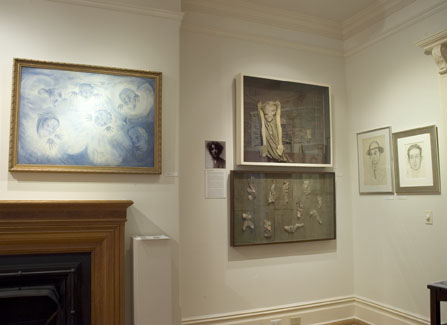 |
|
|
|
|
|
|
|
|
|
|
|
|
|
|
|
|
|
|
|
|
|
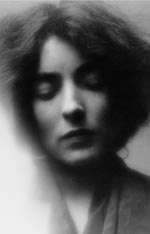 |
|
|
|
|
|
|
|
|
|
|
|
(1882-1966) When Mina Loy arrived in New York at the end of October 1916, her name was already well known in Manhattan’s most radical art and literary circles. The writings of this beautiful and brilliant English poet had been praised by T.S. Eliot and Ezra Pound and had appeared in the leading American avant-garde magazines. Shortly after her arrival in America, she was profiled in The New York Evening Sun as the exemplary “modern woman.” Indeed, if you wanted to know the latest trend, the Sun reporter boasted, just ask Mina Loy. “She can tell what futurism is and where it came from.”
|
|
|
|
|
|
|
|
|
|
|
|
|
|
|
|
|
|
|
|
|
|
|
|
|
While pursuing her literary activities, Loy worked with equal intensity as a visual artist. From childhood, she drew with confidence and, as a teenager, she escaped the confines of her parent’s Victorian home in London to partake of bohemian life, first at an art school in Munich, and then later, in Paris, as a fixture of Gertrude Stein’s and Mable Dodge’s salons. In Paris she married the English painter Steven Haweis and, at the age of 24, was elected a member of the Salon d’Automne, where her work received its first critical notice. Her Florentine years (1907-1916) were marked by an intense infatuation and falling out with the Futurists, particularly F.T. Marinetti and Giovanni Papini (with whom she had tempestuous affairs). In Florence she also met the American writer Carl Van Vechten, who took an active interest in her work. He purchased at least one of her paintings, sent her drawings to galleries and her poems to magazines, thereby encouraging her to live by writing and art-making—which she struggled to do for the rest of her life. |
|
|
|
|
|
|
|
|
|
|
|
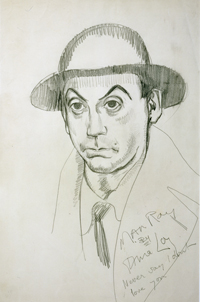 |
|
|
|
|
|
|
|
|
|
|
|
|
|
|
|
|
|
|
|
Portrait of Man Ray, ca. 1925
Pencil on paper, 20 x 12 inches |
|
|
|
|
|
|
|
|
|
|
|
|
|
|
|
Arriving in New York in 1916, Loy found herself at the epicenter of New York’s most advanced literary and artistic scene. Not only was she a sought-after contributor to such renegade magazines as Others and Rogue, but she quickly became a guest at the soirées of Walter and Louise Arensberg. It was in this cultural milieu that her artistic talents first manifested themselves—in exhibitions, publications, performances, and theatrical productions. In 1917, she submitted a painting entitled Making Lampshades to the Independents’ Exhibition, and, a month later, she attended a fancy costume ball dressed as a human lampshade. It was during this period—at one of the evenings at the Arensberg apartment—that she met and fell in love with Arthur Cravan, the proto-Dadaist and poet-boxer (who was best known for his fight against former world-heavyweight Jack Johnson). The tragic love affair between Cravan and Loy is now one of the great legends of twentieth century art, and has itself produced a rich legacy of art in the form of novels, films, and plays. Loy and Cravan were married in Mexico City in 1918, but a year later, when Loy was pregnant with their first child, Cravan mysteriously dropped off the face of the earth. Loy spent a year searching for him, and decades fantasizing his return. Although theories abound, the mystery of his disappearance has never been solved. |
|
|
|
|
|
|
|
|
|
|
|
|
|
|
|
|
|
|
|
|
|
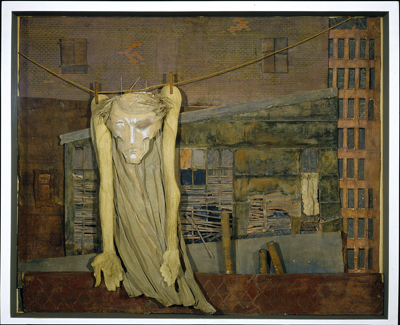 |
|
|
|
|
|
|
|
Christ on a Clothesline, ca. 1955-59
Collage and mixed media in deep glass covered box
24 x 41 ½ x 4 ¼ inches |
|
|
|
|
|
|
|
|
|
|
|
|
|
|
|
|
|
|
|
|
|
|
|
|
In 1923, Loy moved back to Paris and, with financial backing from Peggy Guggenheim, opened a lampshade business, which, presumably, was intended to give her the financial freedom to paint and write. Later, she acted as Paris scout for her son-in-law Julien Levy, identifying many of the artists and choosing the early surrealist works he would show in his New York gallery (a role for which she has never been given her proper due). In 1933, while she was acting as his agent in Paris, Julien Levy gave Mina Loy her first solo show in the United States. |
|
|
|
|
|
|
|
|
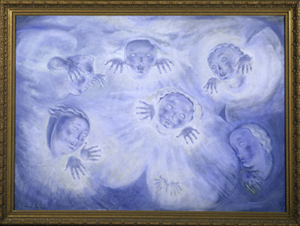 |
|
|
|
|
|
|
|
|
|
|
|
|
Teasing a Butterfly, 1902
Oil on canvas, 33 x 45 inches |
|
|
|
|
|
|
|
|
|
|
|
In 1936, Loy returned to the United States and took up residency in the Bowery. There she lived a marginal existence, preferring the company of those who lived in the streets and alleys to the art and literary crowd she had known, but with which she had now become disillusioned. The derelicts and panhandlers who were now her colleagues were also the subjects of a series of haunting collages and assemblages which she composed out of found objects and the detritus of their natural habitat. In 1959, Marcel Duchamp helped to organize a show of these works at the Bodley Gallery in New York. Although she did not attend the opening, many of her old friends came out to pay their respects—Joseph Cornell, Djuna Barnes, William Copley, Marcel Duchamp and Robert Coates (who reviewed the exhibition for the New Yorker) among them. Mina Loy died in Aspen, Colorado, at the age of 84. |
|
|
|
|
|
|
|
|
|
|
|
|
|
|
|
|
|
|
|
|
|
|
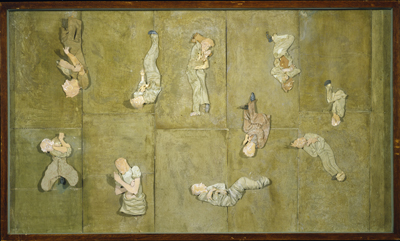 |
|
|
|
|
|
|
|
Communal Cot, ca. 1950
Papier maché and rags, 27 ¼ x 46 ½ inches. |
|
|
|
|
|
|
|
|
|
|
|
|
|
|
|
|
|
|
|
|
|
|
|
|
|
|
|
|
|
|
 |
 |
 |
 |
 |
 |
 |
 |
 |
 |
 |
 |
 |
 |
 |
 |
 |
 |
 |
 |
 |
 |
 |
 |
 |
 |
 |
 |
 |
 |
![[Francis Naumann]](../4logo.gif)





